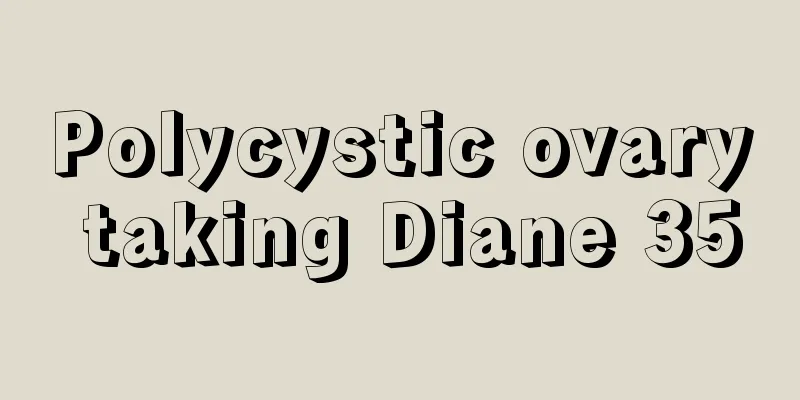Polycystic ovary taking Diane 35

|
There are many treatments for polycystic ovary disease, with medication and surgery being the most common. In terms of drug treatment, taking Diane 35 is the main way to treat polycystic ovary. However, how to treat polycystic ovary is related to the condition. You cannot rely solely on drugs for treatment. Only appropriate methods can ensure the best treatment effect. Let’s take a look at the main treatments for polycystic ovary. Polycystic ovary syndrome is common in ovarian lesions, causing endocrine disorders, menstrual disorders, etc., but this endocrine disorder may be an imbalance of many hormones; for example, high androgen levels are generally treated with Diane 35; low estrogen levels require estrogen supplementation, and high prolactin levels require treatment with drugs such as bromocriptine. Currently, the use of Diane-35 to treat polycystic ovary syndrome is a relatively good measure, and it is generally effective when taken for more than 3 months. Surgery The treatment of PCOS patients has always been a difficult problem in clinical treatment. The earliest effective treatment was bilateral ovarian wedge resection (BOWR) reported by Stein and Leventhal in 1935, which ushered in the era of surgical treatment of infertility. Surgical treatment can reduce some granulosa cells in the ovaries, reduce the production of androgens by the ovarian stroma, and thus reduce the level of circulating androgens, and then reduce GnRH, causing a further decrease in serum androgen concentrations. This also shows that the ovarian stroma is also regulated by the pituitary-ovarian axis. Due to the decrease in androgen levels, most patients can resume spontaneous ovulation and menstruation after surgery, and some may become pregnant naturally, but most pregnancies occur about 6 months after surgery. Surgical treatments are divided into the following categories according to different methods: (1) Bilateral ovarian wedge resection (BOWR) is the earliest and most effective method for treating anovulatory PCOS. The surgery requires the removal of 1/3 of the ovarian tissue. Stein et al. reported that 95% of patients were able to resume normal menstruation after surgery, and the pregnancy rate could reach 85%. Subsequent reports confirmed the effectiveness of this method, but the success rate varied greatly. However, this method has a variety of adverse reactions, including adhesion formation after surgery leading to tubal infertility. There are also reports of premature ovarian failure after surgery. Because this method causes great damage, it is rarely used nowadays. (2) Laparoscopic ovarian electrocautery or laser drilling (LOD) Currently, the preferred surgical treatment method is laparoscopic ovarian drilling using thermal penetration or laser. The response to postoperative ovarian induction treatment is improved, the multiple pregnancy rate is reduced due to medical intervention, and the incidence of postoperative adhesions is significantly reduced compared with ovarian wedge resection. It is mainly suitable for second-line treatment of patients with clomiphene resistance. It has a high rate of single follicles and avoids multiple births and OHSS problems. Especially for those with BMI less than 29 and free androgen index less than 4, the treatment effect is good, with an ovulation rate of 80% to 90% and a pregnancy rate of 60% to 70%. (3) Transvaginal hydrolaparoscopy (THL) is mainly used to examine the fallopian tube and ovarian structure in patients with infertility without obvious pelvic causes. The cumulative pregnancy rate of 6 months after ovarian drilling treatment of clomiphene-resistant PCOS patients reached 71%. 3. Assisted reproductive technology For PCOS patients who have ovulated but have not become pregnant after more than 6 months of standard ovulation induction cycle treatment, or patients who have not ovulated after multiple drug ovulation induction treatments and auxiliary treatments and are in urgent need of pregnancy, assisted reproductive technology such as embryo transfer can be chosen. (1) In vitro fertilization (IIVF) IVF-ET is an effective treatment for patients with refractory PCOS. (2) In vitro oocyte maturation (IVM) is a technology that simulates the maturation environment of oocytes in vivo, allowing immature oocytes collected from the ovaries to reach final maturation in vitro. The high androgen level in PCOS patients makes it easy for them to have too many follicles recruited but maturation disorders during ovulation induction. Therefore, IVM technology provides a new way to treat infertility in PCOS patients. |
<<: Mugwort leaves for polycystic ovary
>>: Polycystic ovary ovulation test strips
Recommend
What is the cause of uterine tumors?
Most doctors will diagnose uterine tumors as uter...
What tricks should be used to defeat HPV infection?
With the improvement of medical knowledge More an...
Why do girls have black spots down there?
The difference between girls and boys is reflecte...
What are the early treatments for ovarian cysts?
Women have a special organ - the uterus, which is...
What does folic acid tablets do?
Folic acid tablets, also known as vitamin B29, ca...
How to maintain the uterus?
We all know that the uterus is the most important...
Can I dance to lose weight after giving birth? What are the ways to lose weight?
Many mothers eat too many nutritional supplements...
Unhappy pain: four unexpected reasons that force women to stop having sex
1Unreasonable bleeding Unless it's her first ...
What should I do if there is a lump on the perineum?
If a lump appears on a woman's perineum, she ...
Why do you lose teeth during childbirth?
Many women are quite strange. They don't know...
What to eat for damp heat? These foods can help you remove dampness and heat from your body
People with a damp-heat constitution will show it...
Can I brush my teeth after a miscarriage?
Abortion is divided into two types: natural abort...
When parents start to act unreasonable, are they just naughty kids or are they “old people gone bad”?
"What's wrong with my mother?" Xiao...
My period can't come. What's going on?
Regular menstruation every month and normal color...
What to do if pregnant women have thyroid abnormalities
Some pregnant women have problems with their thyr...









